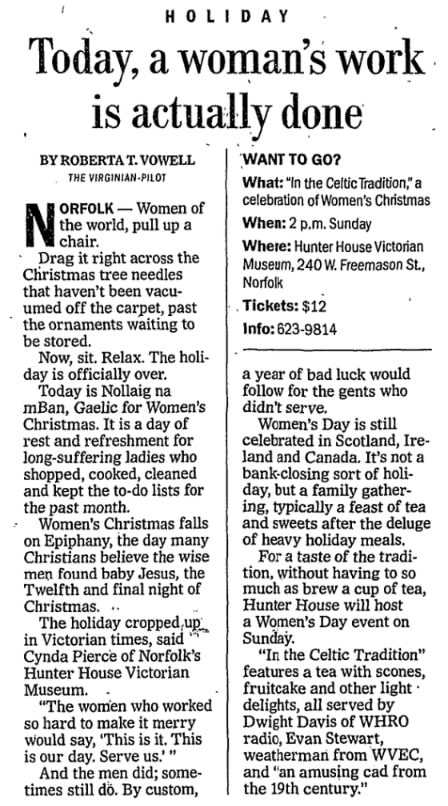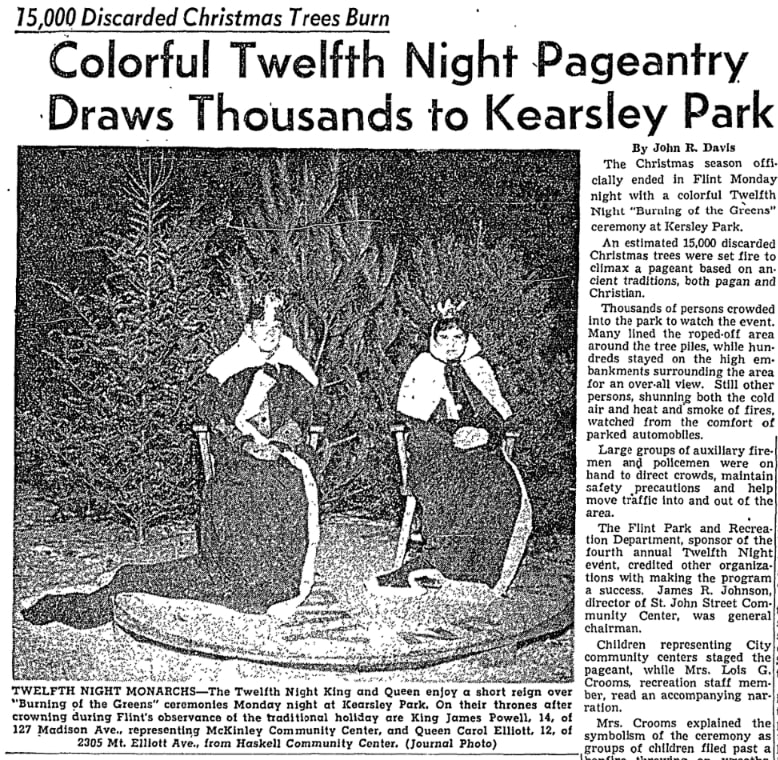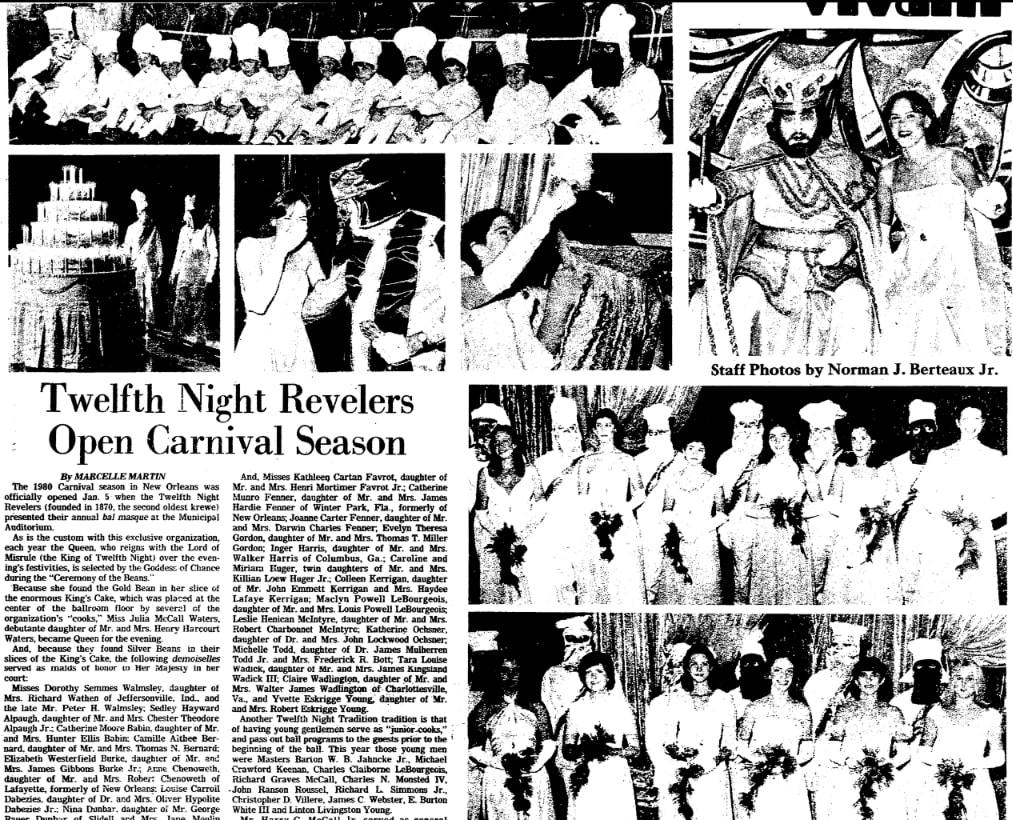Introduction: In this article – to celebrate the traditional end of the Christmas season – Melissa Davenport Berry describes the history and traditions of “Little Christmas.” Melissa is a genealogist who has a blog, AnceStory Archives, and a Facebook group, New England Family Genealogy and History.
Tomorrow, the 6th of January, brings many ways to celebrate and prolong the season of good cheer. The day also has many names, but the most common is “Little Christmas,” also sometimes called “Twelfth Night.” Some celebrate it as the “Feast of the Epiphany,” a day that commemorates the visit of the Magi to the baby Jesus.
Editor’s Note: In various traditions, “Twelfth Night” can refer to either January 5 or January 6. According to Wikipedia:
“Twelfth Night (also known as Epiphany Eve) is a Christian festival on the last night of the Twelve Days of Christmas, marking the coming of the Epiphany. Different traditions mark the date of Twelfth Night as either 5 January or 6 January, depending on whether the counting begins on Christmas Day or 26 December.”
And yet there are even more names and customs for this day. However, one thing is for sure no matter where or how you celebrate: traditionally, there is a temporary suspension of rules and social orders.

Madcap Revelry
In Old England the Feast of Fools was run by the “Lord of Misrule,” who directed activities from Christmas Day until January 6. He would essentially adopt the role of the ruler over all festive fun among the noble court.
In Scotland the festive lord was known as the “Abbot of Unreason,” and in France as the “Prince des Sots [Fools].” Many in America adopted this tradition by hosting their own courtly feast. Read more: Ye Olde Christmas Party Part 1
It is one night of pure folly and dalliance where the Yule Log is the center of the festivities.
Irish Customs
The Boston Herald reported on some Irish Christmas customs.

This article reported:
What is peculiar to Ireland is the way the people have extended the festival to make it literally a mid-winter holiday. Preparations start about the beginning of December and the holiday spirit prevails through Jan. 6 (“Little Christmas Day,” they call it in Ireland) when the holly and Christmas trees are taken down and decorations are put away for another year.
Another name for “Little Christmas” has been coined by the Irish: “Nollaig na mBan,” Gaelic for “Women’s Christmas,” when the women who worked all month to make it merry get to play, and the men stay home (with the children) to take down the Christmas tree and decorations – as well as cook dinner. (It is considered bad luck if they don’t!)

As noted in this next newspaper article featuring a 2005 event hosted by Norfolk’s Hunter House Victorian Museum, the “Nollaig na mBan” holiday “cropped up in Victorian times.”

In this article, Cynda Pierce of the museum says:
“The women who worked so hard to make it merry would say ‘This is it. This is our day. Serve us.’”
That tradition has also been adopted by Scotland and Canada – but lasses, don’t let location stop you from enforcing it!
The Burning of the Greens
Several communities hold an annual “Burning of the Greens” night where the townspeople gather around a bonfire made from Christmas trees, holly, wreaths, and mistletoe to sing carols.
This tradition was adopted from old pagan customs. Christians added more symbolism to its purpose, noting it is to spread light, warmth, and cheer brought forth by the Christ child.
Here is a version celebrated in 1957 by the town of Flint, Michigan, which added a royal theme.

This photo caption read:
Twelfth Night Monarchs – The Twelfth Night King and Queen enjoy a short reign over “Burning of the Greens” ceremonies Monday night at Kearsley Park. On their thrones after crowning during Flint’s observance of the traditional holiday are King James Powell, 14, of 127 Madison Ave., representing McKinley Community Center, and Queen Carol Elliott, 12, of 2305 Mt. Elliott Ave., from Haskell Community Center.
Twelfth Night, the Start of Carnival
For a Southern style night of misrule and decadence, visit New Orleans – where there is never any after-Christmas blues… the party rocks on!
In New Orleans, January 6 (Twelfth Night) marks the start of the Carnival season of Mardi Gras.

Here are some of the activities highlighted by the Mardi Gras New Orleans official website:
- Phunny Phorty Fellows, a band of Twelfth Night revelers, holds its annual ride on the St. Charles Streetcar on January 6.
- In recent years, they have been followed by two other streetcar parades: the Funky Uptown Krewe, and the Société des Champs Elysée.
- Joan of Arc’s birthday is also celebrated on Epiphany. The Krewe of Joan of Arcfeatures historical characters in medieval dress parading through the French Quarter.

Here is one of many Twelfth Night celebrations from 1980. The Revelers, founded in 1870, held their annual masque ball.

According to this article, the Queen (a debutante of the season) reigns with the Lord of Misrule, who is King for the night. The royal pair is selected by the Goddess of Chance via the “Ceremony of Beans.”
This article reported:
Because she found the Gold Bean in her slice of the enormous King’s Cake, which was placed at the center of the ballroom floor by several of the organization’s “cooks,” Miss Julia McCall Waters, debutante daughter of Mr. and Mrs. Henry Harcourt Waters, became Queen for the evening.
And, because they found Silver Beans in their slices of the King’s Cake, the following demoiselles served as maids of honor to Her Majesty in her court.
The King’s Cake is sacred, and thousands like the one pictured above sell every year. It can also be ordered if you are unable to make it.
Explore over 330 years of newspapers and historical records in GenealogyBank. Discover your family story! Start a 7-Day Free Trial
Note on the header image: “Twelfth Night Merry-Making in Farmer Shakeshaft’s Barn,” from Ainsworth’s “Mervyn Clitheroe,” by Phiz, c. 1850. Credit: Wikimedia Commons.
